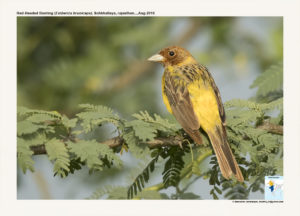
Red-headed Bunting Emberiza bruniceps
Etymology:
- Emberiza : Old German name Embritz for a bunting
- Bruniceps : Latin word brunus brown ; ceps –headed
Vernacular names: Sind: Dalchidi, Hindi: Gandam, Pun: Lal sir boli, Guj: Lal mathano gandam, Lal shir gandam, Te: Pacha jinuwaji, Mar: Lal Dokyacha bharit
Distribution in India: Winter visitor in West and passage migrant in North West.
Description: Size of 15-16 cm. Male breeding is very distinctive, with head down to breast red-brown, hind neck and most of upperparts yellowish-olive, mantle and back with dark streaks, rump yellow, upper tail-coverts brown with yellow tinge, rest of wing feathers dark brown. Male non-breeding has is paler than breeding colours, rufous apparent on breast and ear-coverts. Female breeding is less marked streaks on upperparts, bright yellow rump (absent in first-winter plumage on both sexes), and dirty yellowish-white underparts; has chestnut on fore crown, face, and chin to breast center. Female non-breeding has yellow more apparent on underparts.
Habitat: It is found in bushes on pure steppes, also in semi-desert and desert oases; occupies all kinds of tall herbaceous vegetation and shrubs.
Food Habits: It eats seeds throughout year; during breeding season, feeds mostly on invertebrates. Feeds mostly on ground, but also in shrubs and bushes. Singly and in pairs when breeding. In winter typically found in medium-sized flocks; often in large mixed flocks with Black-headed Bunting
Breeding Habits: They breed in June-Aug. The nest is built entirely by female, composed of grass, twigs, stalks, moss and hair, lined with fine grass, lichens and hair, placed on ground and concealed in grass tussock, occasionally on tree stump or low down in tree. They lay a clutch of 4–6 eggs. The incubation is done by both sexes. The incubation period is 11–12 days. The chicks are fed by both sexes. Its natural food consists of insects when feeding young for easier digestion for chicks and water content in the worms supply the chicks with their water requirements. Also the protein helps them grow faster. The chicks leave nest 6–8 days after hatching, still unable to fly, fully fledged 3–5 days later. The chicks are fed by both parents.